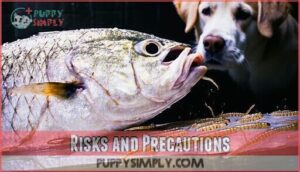This site is supported by our readers. We may earn a commission, at no cost to you, if you purchase through links.

You’ll want to thoroughly cook the skin first, as raw fish skin can harbor parasites that’ll make your pup sick.
Think of cooked fish skin as nature’s multivitamin – it’s packed with omega-3 fatty acids, protein, and essential nutrients that support your dog’s coat, joints, and overall health.
However, you should remove all scales and bones before serving, and skip any seasonings or oils.
Not all fish are created equal though, and portion size matters more than you might think, so the key lies in choosing the right types and preparing them correctly.
Table Of Contents
- Key Takeaways
- Fish Skin Nutrition
- Can Dogs Eat Cooked Fish Skin
- Health Benefits Explained
- Safe Fish Types Identified
- Preparation Methods Matter
- Risks and Precautions
- Fish Skin and Dental Health
- Feeding Guidelines Established
- Alternatives to Fish Skin
- Ensuring Safe Consumption
- Frequently Asked Questions (FAQs)
- Conclusion
Key Takeaways
- You can safely feed your dog cooked fish skin when it’s thoroughly cooked, properly prepared without scales or bones, and served plain without seasonings or oils.
- Choose low-mercury fish like salmon, cod, sardines, and herring while avoiding large predatory fish such as shark, swordfish, and king mackerel that contain higher toxin levels.
- Start with small portions (about an ounce per 10 pounds of body weight) and limit fish skin treats to 2-3 times per week while watching for allergic reactions or digestive upset.
- Fish skin provides valuable omega-3 fatty acids and protein that support your dog’s coat health, joint function, and dental care through natural chewing action.
Fish Skin Nutrition
Fish skin packs impressive nutritional value that makes it worth considering as an occasional treat for your dog.
You’ll find it’s loaded with omega-3 fatty acids, high-quality protein, and essential vitamins that can support your pet’s overall health, including benefits from high-quality protein.
Omega-3 Fatty Acids
Fish skin packs omega-3 powerhouses that’ll make your dog’s health shine.
Fish skin: nature’s superfood that transforms your pup into a shiny-coated, energetic powerhouse.
When you feed cooked fish skin dogs love, you’re delivering essential DHA and EPA benefits that work like natural medicine.
These omega3 fatty acids in fish skin nutrition dogs need support three key areas:
- Inflammation reduction – Eases joint pain and skin irritation
- Cognitive function – Sharpens mental alertness and learning
- Heart health – Strengthens cardiovascular function
These omega-3 sources deliver real fish skin benefits dogs can’t get elsewhere.
Protein Content
Cooked fish skin dogs absolutely love provides high-quality protein that’s easily digestible.
This complete protein contains all essential amino acids your dog needs for muscle development and repair.
The protein digestibility rate exceeds many other sources, supporting immune function and hormone production efficiently, with fish skin’s protein content typically ranging from 70-80%, making it an excellent supplement to your dog’s regular diet when prepared safely.
Vitamins and Minerals
Beyond protein and omega-3s, cooked fish skin delivers essential vitamins like B12 and D, plus minerals including selenium, calcium, and zinc that boost your dog’s health.
These nutrients support red blood cell formation, bone strength, and immune function while offering superior bioavailability factors compared to synthetic supplements.
The natural mineral absorption from fish skin helps prevent deficiency symptoms without supplementation risks, making it a nutritionally complete treat for ideal dog nutrition.
Can Dogs Eat Cooked Fish Skin
Yes, dogs can safely eat cooked fish skin when properly prepared. This nutrient-packed treat offers excellent benefits for your furry friend’s health and wellbeing.
Key considerations for feeding dogs fish skin safely:
- Choose appropriate skin cooking methods like baking, grilling, or steaming without oils
- Select quality fish skin sourcing from reputable suppliers or trusted fishmongers
- Consider breed specific needs, as smaller dogs require smaller portions
- Compare homemade dog treats versus commercial fish treats for convenience
- Always make certain cooked fish skin is completely cooled before serving
Health Benefits Explained
When you give your dog properly cooked fish skin, you’re providing them with a nutritional powerhouse that supports their health in several key ways.
The omega-3 fatty acids and high-quality protein in fish skin work together to enhance your pet’s coat shine, improve their digestion, and reduce joint inflammation.
Improved Coat Health
Within weeks of adding cooked fish skin to your dog’s diet, you’ll notice dramatic improvements in coat health.
The omega-3 fatty acids work like nature’s conditioner, boosting coat shine while reducing excessive shedding.
These essential fats promote skin hydration from within, often providing allergy relief for dogs with sensitive skin, and remember, breed differences affect results—thick-coated breeds may show changes more gradually than their short-haired counterparts, due to the omega-3 fatty acids.
Enhanced Digestion
Through gentle oils and natural enzymes, fish skin digestion dogs experience improved digestive tract function.
The high digestibility of properly cooked fish skin soothes sensitive stomachs while supporting healthy gut microbiome balance.
Unlike processed treats, fish skin’s natural fiber content promotes better stool quality without causing gastrointestinal upset.
Your dog’s digestive enzymes can easily break down this wholesome protein source, making it an excellent choice for maintaining ideal digestion and supporting a healthy gut microbiome balance.
Joint Health Support
Fish skin’s omega-3 fatty acids work like nature’s anti-inflammatory medicine for your dog’s joints.
These healthy fats reduce inflammation that causes stiffness and discomfort in aging pups.
Dogs with arthritis often show improved mobility after regular omega-3 consumption.
The EPA and DHA in fish skin help protect cartilage from breaking down while supporting overall joint function.
It’s particularly beneficial for active breeds prone to joint issues.
Safe Fish Types Identified
When choosing fish skin for your dog, you’ll want to stick with smaller, wild-caught fish like salmon, sardines, cod, and herring since they contain lower mercury levels and fewer environmental toxins.
Avoid large predator fish such as shark, swordfish, and king mackerel, as these accumulate higher concentrations of harmful substances that can affect your pet’s health.
Wild-Caught Options
When considering wildcaught fish for your dog’s diet, smaller species offer nutritional superiority over their farmed counterparts.
Despite sourcing challenges and cost comparison concerns, these options provide safer fish skin safe dogs can enjoy without the antibiotics found in farm-raised varieties.
Here are your best wildcaught options for dogs and fish skin treats:
- Salmon and cod – Rich in omega-3s with lower toxin levels
- Herring and sardines – Sustainable sources with excellent nutrient profiles
- Whitefish and flounder – Gentle on sensitive stomachs
- MSC-certified options – Addresses sustainability impact and regional availability concerns
Many owners also purchase wild caught fish for their pets.
Low-Mercury Fish
Mercury acts like an unwelcome guest in your dog’s system, so choosing the right safe species matters.
Salmon, sardines, and light tuna contain lower mercury levels than larger predatory fish. These safe fish types provide essential nutrients without toxic buildup.
When selecting cooked fish skin for your pup, stick to smaller fish caught through sustainable fishing practices. Always verify mercury content before adding new fish skin safe dogs can enjoy to their diet.
Sustainable Sources
When choosing fish skin for your dog, sustainable sourcing matters more than you might think.
Look for Marine Stewardship Council certified products that support eco-friendly fishing practices.
Wild-caught options from sustainably managed fisheries help reduce overfishing while avoiding farmed fish concerns like antibiotics and crowded conditions.
Sustainable seafood choices protect marine resources and guarantee cleaner, healthier treats for your furry friend.
Preparation Methods Matter
How you prepare fish skin makes all the difference between a healthy treat and a potential hazard for your dog.
You’ll need to cook it thoroughly, remove all scales and bones, and skip any seasonings or oils that could upset your pet’s stomach.
Cooking Techniques
The best cooking methods for preparing cooked fish skin involve gentle techniques that preserve nutrients while eliminating harmful bacteria.
Baking methods at 350°F create crispy textures, while steaming options maintain moisture and digestibility.
Grilling fish skin works well but requires careful monitoring to prevent burning, however, frying concerns arise due to added oils that dogs shouldn’t consume.
Fish skin offers potential health benefits and provides potential benefits. Recipe variations should always prioritize plain preparation without seasonings for ideal dog food safety.
Removing Scales and Bones
After mastering cooking techniques, you’ll need proper preparation tools to tackle scale removal and bone identification.
Think of this step as detective work – missing even tiny fish bones creates serious choking hazards when feeding dogs fish skin.
Here’s your safety checklist for cooked fish skin preparation:
- Scale removal using a fish scaler or knife edge
- Bone identification with tweezers for small remnants
- Safe techniques including thorough visual inspection
Avoiding Additives
Once you’ve cleaned the fish skin, keep things simple when cooking.
Skip the butter, olive oil, and seasonings that make human food taste great. These additives can upset your dog’s stomach or worse.
Salt risks dehydration, while spice concerns include potential toxicity. Oil dangers mean unnecessary calories and digestive issues.
When feeding dogs fish skin as cooked fish skin treats, stick to plain preparation. Your pup doesn’t need artificial flavors or preservative avoidance becomes essential for safe dog treats, focusing on safe dog treats.
Risks and Precautions
While cooked fish skin offers nutritional benefits for your dog, you’ll need to watch for potential risks that could affect their health.
Raw or improperly prepared fish skin can harbor dangerous parasites and bacteria, while some dogs may develop allergic reactions or experience digestive upset from environmental contaminants.
Parasites and Bacteria
Why does raw fish skin pose such serious health risks to your furry friend? Raw fish risks include dangerous parasites and bacteria that can make your dog seriously ill.
Safe cooking temps eliminate these threats, making cooked fish skin a healthier option. Preventative measures through proper cooking protect your pet’s health from harmful microorganisms.
Watch for these warning signs of bacterial contamination:
- Vomiting or diarrhea after eating
- Loss of appetite or lethargy
- Fever or unusual behavior
- Difficulty breathing or swallowing
- Skin irritation or excessive scratching
Preventative measures through proper cooking protect your pet’s health from harmful microorganisms, and recognizing these signs can help you take immediate action to ensure your dog’s well-being and safety, which is a critical requirement.
Allergies and Sensitivities
While bacterial infections pose one concern, allergies and food sensitivities present another challenge when introducing fish skin to your dog’s diet.
Fish allergies aren’t common in dogs, but they can develop over time. Watch for telltale signs like excessive itching, skin redness, or digestive upset after feeding fish skin.
| Allergy Symptoms | What to Watch For |
|---|---|
| Skin reactions | Itching, hives, redness |
| Digestive issues | Vomiting, diarrhea |
| Respiratory signs | Coughing, sneezing |
Veterinarian consultation helps identify specific allergens through sensitivity testing or elimination diets, especially if your breed shows predisposition to allergic reactions.
Environmental Contaminants
Fish skin can harbor environmental contaminants that pose serious health risks to your dog.
Heavy metals like mercury accumulate in fatty tissue, while PCBs and dioxins from industrial pollution concentrate under the skin.
Fish farming operations often increase toxin levels due to crowded conditions and environmental pollution.
The overfishing impact has pushed many suppliers toward less sustainable sources, potentially exposing pets to higher contaminant levels through poor-quality fish.
Fish Skin and Dental Health
You’ll be surprised to learn that cooked fish skin can actually help clean your dog’s teeth while they chew, acting like a natural toothbrush that scrapes away plaque and tartar buildup.
This chewy texture provides a gentle abrasive action that supports gum health and fresher breath, making it both a tasty treat and a dental care tool.
Reducing Plaque and Tartar
Your dog’s chompers will thank you when they gnaw on properly prepared fish skin.
The naturally abrasive action works like sandpaper against your pup’s teeth, scraping away stubborn plaque before it hardens into tartar. This chew texture stimulates saliva production, which contains natural enzymes that break down bacteria. Think of it as your dog’s personal dental assistant – working overtime while they enjoy their treat.
Here’s how fish skin supports dog dental care:
- Mechanical cleaning – The rough surface physically removes plaque buildup through abrasive action
- Natural breath improvement – Reduced bacteria means fresher doggy breath
- Enzymatic action boost – Increased saliva flow activates natural cleaning enzymes
This dog teeth cleaning method beats expensive dental chews hands down.
Supporting Gum Health
Beyond removing plaque buildup, the natural chew texture of cooked fish skin provides gentle gum massage that promotes healthy circulation in your dog’s mouth.
When your pup gnaws on fish skin, it stimulates saliva production, which naturally cleanses bacteria and food particles while supporting overall dental health. This increased saliva flow helps prevent disease by maintaining proper pH levels in the mouth.
Many pet owners notice breath improvement after incorporating fish skin treats into their dog’s routine. The mechanical action of chewing works like a natural toothbrush, reaching areas regular brushing might miss.
This simple addition to dog dental care can substantially impact your pet’s oral hygiene when combined with regular dog teeth cleaning practices, promoting healthy circulation and proper pH levels in the mouth, which is essential for overall dental health.
Feeding Guidelines Established
When you’re ready to add cooked fish skin to your dog’s diet, you’ll need clear guidelines to verify you’re feeding the right amounts at the right times.
Following proper portion control and watching for your dog’s reactions will help you safely introduce this nutritious treat while avoiding potential digestive upset or overfeeding.
Portion Control and Frequency
When determining how much cooked fish skin to give your dog, think of it like adding sprinkles to ice cream—a little goes a long way. Following proper Daily Limits guarantees your pup gets the benefits without overdoing it.
Most veterinary advice suggests an ounce of fish per 10 pounds of body weight, served 2-3 times weekly as part of their regular dog diet.
Here’s your portion control roadmap:
- Puppy Portions: Start with half the adult serving size for growing dogs
- Treat Frequency: Limit fish skin to 2-3 times per week maximum
- Calorie Counting: Factor fish skin into your dog’s total daily calorie intake
- Weight Management: Reduce other dog treats when adding fish skin to dog food
- Serving Size: Use the 10% rule—treats shouldn’t exceed 10% of daily calories
Observing Reactions
After establishing proper portions, you’ll want to monitor your furry friend closely for any changes.
Watch for allergy symptoms like excessive scratching, red patches, or swelling around the face and paws. Digestive changes often appear first – loose stools, vomiting, or unusual gurgling sounds signal your dog’s system isn’t agreeing with the new treat.
Behavioral shifts matter too; if your normally energetic pup becomes lethargic or restless, take note.
Skin reactions can develop gradually, so check for rashes or irritation during your regular petting sessions. Stool consistency tells a story – anything outside their normal range warrants attention before continuing cooked fish skin treats.
Alternatives to Fish Skin
If you’re concerned about fish skin’s environmental impact or your dog has fish allergies, you’ve got plenty of nutritious alternatives that’ll keep your pup happy and healthy.
Plant-based options like hempseed oil and green-lipped mussels provide omega-3s, while organ-based treats offer similar protein benefits without the sustainability concerns.
Plant-Based Options
Several plant-based alternatives can provide similar nutritional benefits without the environmental concerns of fish skin.
You’ll find these options particularly useful if your dog has fish allergies or you prefer sustainable choices.
Here are five excellent plant-based omega-3 sources for dogs:
- Hempseed oils – Rich in omega-3s and easily digestible
- Phytoplankton – Marine algae packed with DHA and EPA
- Flaxseed – Ground seeds offer alpha-linolenic acid
- Chia seeds – Tiny powerhouses of plant-based omega-3s
- Algae supplements – Direct source of vegan omega-3s
While vegetarian dog food and tofu for dogs aren’t complete replacements, legume benefits include protein and fiber.
These vegetable-based treats work well alongside traditional diets, offering plant-based protein alternatives.
Organ-Based Alternatives
Looking beyond traditional fish skin treats, organ-based alternatives offer exceptional nutritional value for your dog’s health.
Liver benefits include high concentrations of vitamin A and iron, supporting immune function and energy production. Kidney nutrients provide essential B vitamins and selenium, while spleen advantages encompass rich iron content for blood health.
Heart health improves with cardiac muscle treats containing CoQ10 and taurine. Lung support comes from respiratory organ treats rich in protein and minerals.
These alternatives answer "is fish skin healthy dogs" concerns by providing similar nutritional benefits without ocean-sourced contaminants. When considering dog diet fish skin options, organ meats deliver concentrated nutrition that supports overall dog health fish skin goals through sustainable, land-based sources, promoting overall dog health and sustainable sources.
Ensuring Safe Consumption
You’ve learned about fish skin’s benefits and risks, but proper preparation and sourcing make all the difference between a healthy treat and a potential problem.
Following specific safety guidelines and monitoring your dog’s response guarantees you’re providing maximum nutrition while minimizing health risks.
Choosing Reputable Sources
When shopping for fish skin treats, source credibility matters more than flashy packaging.
Look for brands with transparent testing practices and certification labels that verify sustainable fishing methods. Your veterinarian can recommend trusted manufacturers who prioritize pet food safety over profits.
Research the fish origin—wild-caught options from clean waters typically contain fewer contaminants than farm-raised alternatives. Consider that some brands specialize in chewy fish skins for dental health.
Quality sources invest in third-party testing and openly share their manufacturing standards with concerned pet parents.
Following Preparation Guidelines
Proper preparation transforms fish skin into a safe treat for your dog.
Cook fish skin to 145°F internal temperature, ensuring thorough cooking without oil or seasonings.
Remove all scales and bones before serving – they’re choking hazards your pup doesn’t need.
Start with small pieces for gradual introduction, watching how your dog responds.
Following these preparation steps makes cooked fish skin a healthy addition to your pet’s diet, and with proper preparation, it can be a valuable part of their meals.
Monitoring Health and Adjusting
After establishing proper preparation methods, you’ll need to watch your dog closely for any changes.
Monitor for fish skin allergy dogs symptoms like itching or gastrointestinal upset. Check stool consistency and note any weight changes or shifts in appetite assessment.
Food sensitivities can develop over time, affecting digestion differently. If you notice concerning reactions, reduce portions or stop feeding fish skin entirely.
When in doubt, seek veterinarian advice for personalized guidance.
Frequently Asked Questions (FAQs)
Can dogs eat fish?
Yes, dogs can eat fish when it’s properly prepared.
Cook it thoroughly, remove all bones, and skip seasonings.
Fish provides excellent protein and omega-3 fatty acids that support your dog’s coat, joints, and overall health.
Can dogs eat cooked fish skin?
Cooked fish skin is safe for your dog when properly prepared.
Remove scales and bones, cook thoroughly without seasonings, and serve in moderation.
It’s packed with omega-3s and protein for healthy coats.
Can dogs eat salmon skin?
Just like finding treasure in your pantry, salmon skin becomes a nutritious treat when properly cooked.
You can safely feed your dog thoroughly cooked salmon skin after removing scales and bones completely.
Can dogs eat fatty fish?
Your dog can enjoy fatty fish in moderation, but proceed with caution.
While rich in omega-3s, fatty fish pose higher toxin risks and may cause pancreatitis.
Choose smaller species and limit portions.
Is fish skin toxic to dogs?
Like walking through a minefield, fish skin isn’t inherently toxic but carries hidden dangers.
Raw skin harbors parasites and bacteria, while cooked versions can contain environmental toxins like mercury, making careful preparation essential.
Can dogs eat fish oil?
Yes, you can give your dog fish oil supplements.
They’re packed with omega-3 fatty acids that support healthy skin, coat, joints, and brain function.
Start with small doses and consult your vet first.
What fish skin can dogs eat?
While toxic fish lurk in deep waters, safe options abound for your pup.
You can feed salmon, cod, sardines, herring, and whitefish skin—but always cook thoroughly, remove scales and bones first.
Why can’t dogs eat cooked fish?
Actually, dogs can eat properly cooked fish.
The concern isn’t cooked fish itself, but raw fish containing harmful parasites and bacteria.
Always remove bones, scales, and avoid seasoning when preparing fish for your pup.
Can you give dogs cooked salmon skin?
You can give dogs cooked salmon skin when it’s properly prepared. Remove all bones and scales, cook thoroughly without oil or seasonings, and serve in moderation as an occasional treat.
What fish can dogs not eat?
Swimming against the current can be dangerous—avoid feeding your dog shark, swordfish, king mackerel, tilefish, or albacore tuna.
These large predatory fish contain high mercury levels that’ll harm your pup’s health.
Conclusion
While some pet owners worry about giving their dogs anything beyond kibble, cooked fish skin can actually be a nutritious addition to your dog’s diet when prepared correctly.
Remember that the key to safely answering "can dogs eat cooked fish skin" lies in proper preparation, choosing low-mercury varieties, and monitoring portion sizes.
Start with small amounts, watch for any adverse reactions, and consult your veterinarian if you have concerns about incorporating this protein-rich treat into your pup’s meal plan.


















